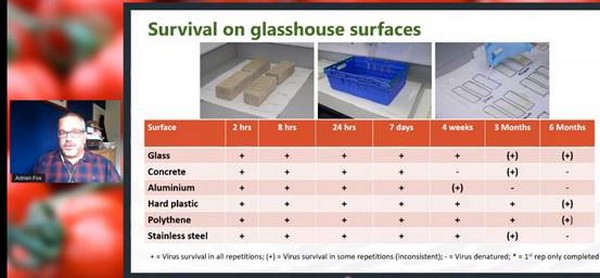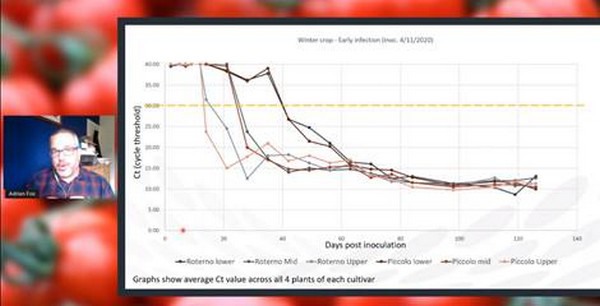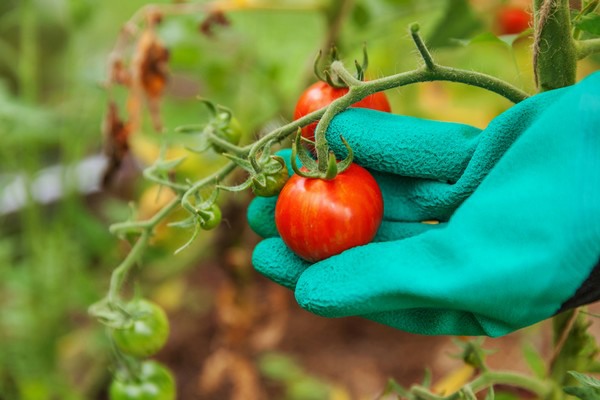That ToBRFV is a fast-spreading virus, and very hard to get rid of once it has entered your greenhouse, has already become clear to most in the industry. With his research for AHDB and Defra, Adrian Fox with Fera Science Ltd discovered that to most surfaces, the virus survives for at least a month, and could still be transmitted then. During yesterdays British Tomato Conference, he and other experts shared their insights.
“What we wanted to know was how robust the virus is. So we set up trials to look at the vitality of the virus. We inoculated surfaces with infected sap to check how long it took for the virus to disappear. On most surfaces, a month was not enough. Then we did the same with plants, waiting for three weeks for symptoms to develop.”

Infection and symptoms.
When it comes to checking whether a greenhouse is actually infected with ToBRFV, a diagnosis is often done when someone notices symptoms. However, the virus is usually detectable several weeks before that. In his research, Adrian found out that it also mattered where the sample was taken.
“Regardless of the variety we tested, infection was detectable in the upper part at around 2 weeks after we infected the plants. Then it took for almost two week for the infection to be detected in the middle of the plant, and another two weeks for the bottom part. So it is crucial for growers to take samples from the top leaves of the plant as there can be a month between the results.”

Besides, it took some time for the infection to be actually visible. Some plants even didn’t display any symptoms at all. “Some of the plants got symptoms after 11 weeks, and for some plants, you might never notice the infection at all. The earliest detection of infection happened at 49 days.”
Adrian stressed the important of more accessible testing methods. “Usually, 200 leaves are taken for a sample. However, in a large greenhouse this might seem a needle in a haystack. But taking more samples means more work. Besides, our research clearly shows that symptoms are not a reliable measure of infection. What the industry needs is more accessible, passive methods of testing. This way, growers won’t have to wait for an inspector to bring the bad news. We will be investigating testing via irrigation channels. By the end of October we will start this research.”

© Iuliia Zavalishina | Dreamstime.com
Hygiene is essential
‘Have a robust plan in place the virus is detected at your greenhouse. Don’t be to quick to think you will be left out”, said David Kaye with ADAS horticulture. In his talk “managing ToBRFV and glasshouse hygiene,” based on field research in Europe and the UK, he stressed the importance of structural measures.
“In most greenhouses, there are already strict hygiene measures. However, along with disinfecting everything and providing yoru staff with the right supplies, it is critical to manage who is entering the greenhouse at all.” In fact, hospitality and ToBRFV prevention don’t go together easily. “We always advice growers to provide supplies such as boots and clothes for their visitors, as they might have visited another greenhouse before. But people entering the greenhouse always pose a risk. Always consider whether a visit is actually essential, or whether it could take place in a local pub or online.”
Staff training
Along with visitors, staff awareness is another factor that can benefit growers. “Some growers don’t train their staff at all, as they want them to start working as quickly as possible. I know that staff shortage can put growers in a tight spot. But having your staff understand the measures you are taking is of key importance. Also, if they know what symptoms to report, you might be able to take more accurate measures.”
As Dave concluded, “an ounce of prevention is worth more than a ton of cure. Disease avoidance is critical. Undertake any necessary maintenance work as muddy things are harder to disinfect. Any measure you take, will pay itself back.”
The sessions will be available to watch at www.britishtomatoes.co.uk.
